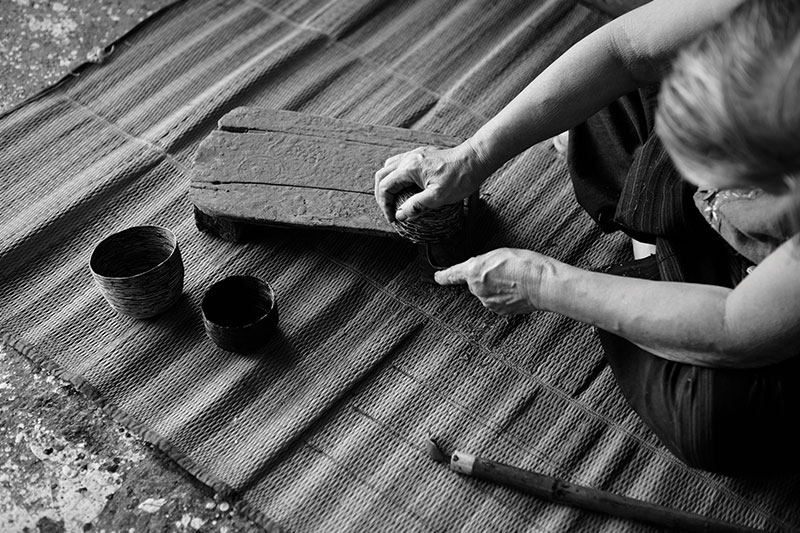
Sustainable Chiang Mai: Stories of Little People Making Big Differences
Discover the north’s creative soul – where culture, craftsmanship and conscious living weave a delightful tapestry of travel experiences
Words & Photos: P/K/A
Looking to dive into Thai traditions while also giving back to local communities as you explore? Get to know Chiang Mai through the stories of “little people” who are nurturing the nature, arts and craftmanship that this popular northern destination is famous for.
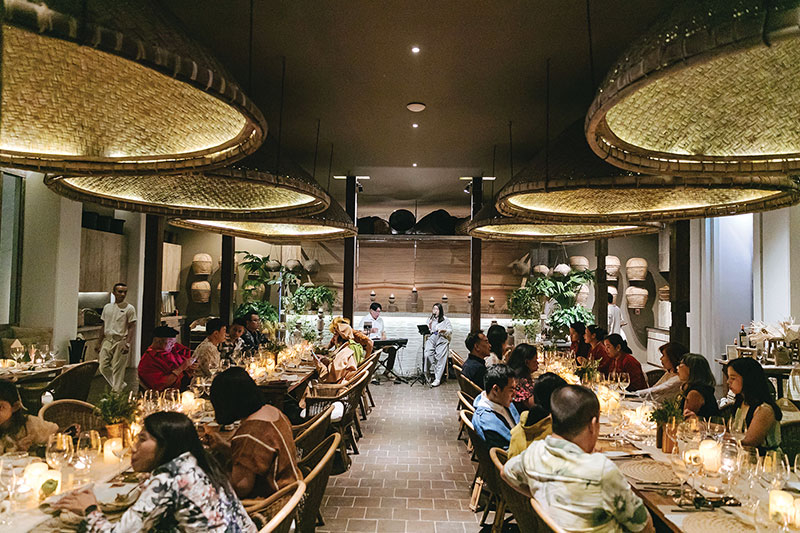
From Local Crafts to Contemporary Looks
Our voyage begins along the tranquil banks of the Ping River, where Raya Heritage Hotel stands as a beacon of sustainable practices.
Collaborating with local artisans in small villages, the hotel breathes life into traditional bamboo crafts. The interior is adorned with woven fishing traps – torpedo-shaped sae, vase-styled khong and basket-like sum – as well as mats knitted from yaeng (calathea plant) fibre and bamboo khu khao threshing baskets.
Tipchaya Phongsathorn, CEO Real Estate & Hotel Business of Raya Collection and founder of Food for Good Program, Yuvabadhana Foundation, explains that the decor theme takes pride in local craftmanship, preserving ancient weaving skills that evoke Lanna culture’s simple yet elegant balance with nature.
These traditions blend with contemporary style in one-of-a-kind furniture pieces. For instance, the woven mats become upholstery that lends benches a striking rustic look while large bamboo threshing baskets serve as ceiling lamps at Khu Khao, the hotel’s signature restaurant. Bamboo baskets and fans also decorated the tablet at a charity dinner held at Khu Khao on October 20. Yuvabadhana Foundation partnered with Bangkok Airways and invited chef Fang-Natthaphong Norchuwet to craft a tantalising six-course meal that showcased delicious local ingredients. All proceeds from the dinner went to the Food for Good project to combat malnutrition among children in rural areas.

Clothing to Raise Consciousness
As well as presenting traditional Lanna ways via everyday woven items, Raya Heritage evokes daily life of Doi Tao villagers through the Satu brand of clothing available at its boutique shop. Satu was founded by Doi Tao native Saksaran Duang-in, who wanted to create sustainable livelihoods for his family and community while reducing environmental impact.
An agriculture graduate who worked for non-governmental organisations, Saksaran returned to his home village and joined his mother, a dressmaker, to produce unique clothing made from soft hemp and naturally dyed cotton. He travels 125 kilometres from Doi Tao to sell his unusual clothing at Jing Jai Market in downtown Chiang Mai every Saturday and Sunday.
“The Satu brand sells not just clothing but the story around it. Fashions come and go, but our products are designed to remind people to live their lives mindfully. For example, one shirt is embroidered with the word ‘Sati’ [consciousness] upside-down so the wearer can read this word and be aware that death can happen anytime,” says Saksaran.
The unusual ideas for his clothing do nto rely on perfect, balanced patterns, while the charm of ethnic crafts such as Hmong batik and Karen backstrap weaving have earned fame for the Satu brand. Over the past eight years, Saksaran has created jobs and incomes for elderly Doi Tao villagers who help in the dyeing, tailoring, and embroidering of his products.
“The seniors in my village earn a daily income of 300-400 baht each,” he explains.
“The happiest among them is my mother, who is also my business partner. At first, she was very worried when I quit my job and returned home, because she had no idea what I would do next. Now she is proud to be helping create sustainable livelihoods in the community through the Satu brand.” www.facebook.com/Satu.doitao
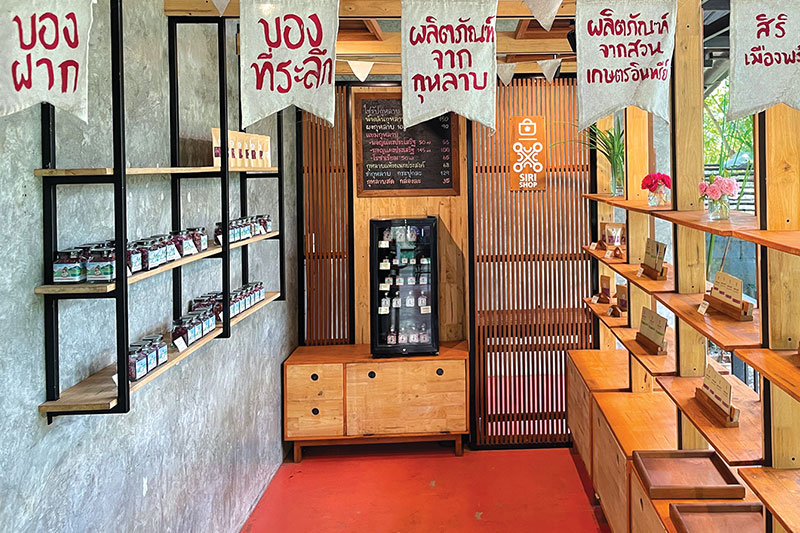
A Sanctuary of Community Spirit
A two-hour drive through the mountains from downtown Chiang Mai, the small Phrao district lies off the tourist map despite its tranquil and beautiful surroundings. However, visitors who do make the long trip are rewarded with Siri Mueang Phrao, a cosy sanctuary containing a delightful library, art gallery, organic farm, café, and souvenir shop.
Four years ago, the multitalented Karaket Sriparinyasin – a writer, former editor of Praphansarn Publishing House and astrologer at www.kapook.com – persuaded her siblings to return to their hometown and create a new local landmark. As well as tightening the family bond, Siri Mueang Phrao also provides jobs and other benefits for people in the community.
“Sure, we admit what we do is very ideological. Starting a business during a pandemic? Like pouring money down the drain,” she says.
“But the risk is worth it when we can spark inspiration in visitors. If a book from our library can inspire a child’s journey through life, then our efforts have been worthwhile.”
Siri Mueang Phrao has been a dream for the Sriparinyasin family, and now each member has helped make it come true.
Karaket’s younger sister oversees the library, while her brother-in-law uses his mother’s recipes to craft both savoury and sweet treats in the kitchen. Karaket’s older brother takes care of the organic rose garden, which produces jam, food colouring, and ingredients for the drink menu. Karaket herself serves as a designer of souvenirs inspired by her father’s expertise in Lanna astrology.
Today, Siri Mueang Phrao has evolved into a community learning centre and sanctuary, providing a space for children to read, join art workshops, and play. At the café, adults can try budget-friendly treats made from local ingredients – including rose mocktails, rose tea, and scones with rose jam – in stunning natural scenery.
Siri Mueang Phrao is not just a family venture but a joint effort with the Phrao community that generously invites tourists to share the local way of living in harmony with nature. www.facebook.com/siriphrao
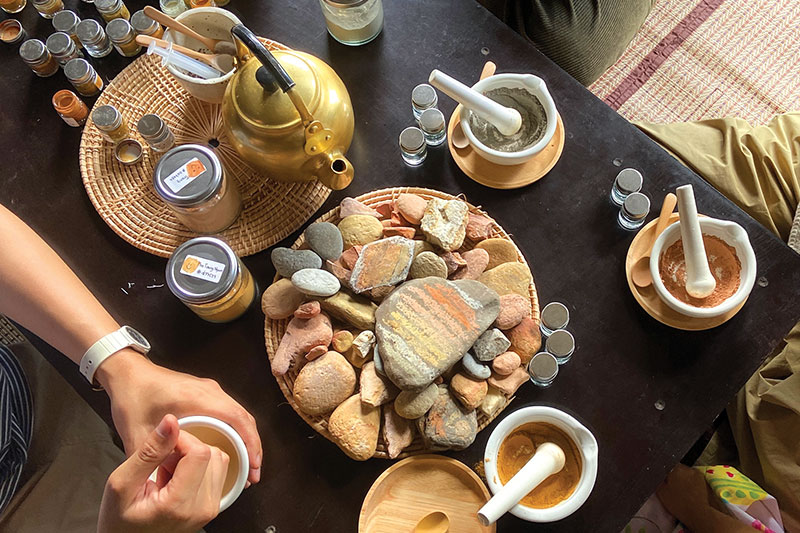
Colours from the Forest
Our journey takes an artistic turn with Chanoknan Nanthawan and his playful answers to local environmental challenges. An environmental researcher and social activist, Chanoknan runs the Somdul-Chiang Mai Facebook page which uses creativity to tackle PM2.5 dust pollution, forest fires, and the roots of slash-and-burn agriculture that feed them.
Chanoknan’s environmental research led him to Baan Mae John in Chiang Dao district, where he discovered children joyfully painting their faces and bodies with natural colours made from earth and stones. Inspired, he came up with the workshop “Colours for a Balanced Happiness”, using nature’s palette to explore the importance of watershed forests, natural resources, and the environment.
“I want to take environmental issues out of the box of academic approach,” says Chanoknan. The art workshop is a practical and enjoyable way to gain appreciation for nature while becoming a more responsible traveller. Children and tourists alike are invited to extract colours from four communities in Chiang Dao and one in the southern province of Trang. They then use the natural paints to create artworks that tell unique stories of each locale.
Beyond the workshops, Chanoknan and his scholar friends collaborate with villagers in Baan Mae John to promote eco-community tourism. Forest ecology experts tap local wisdom to share fascinating insights with tourists. Product designers contribute by developing unique colour patterns and designs for local handicrafts that meet the contemporary tastes of tourists.
The workshop “Colours for a Balanced Happiness” unfolds every first Saturday of the month at Bamboo Family Market in San Kamphaeng district, Chiang Mai. This engaging initiative, coupled with the display of handicrafts by Baan Mae John villagers, sets the stage for an eco-tourism route starting in January, after the harvest season.
Stay tuned for updates by following www.facebook.com/SomdulChiangMai and www.facebook. com/bamboofamilymarket.
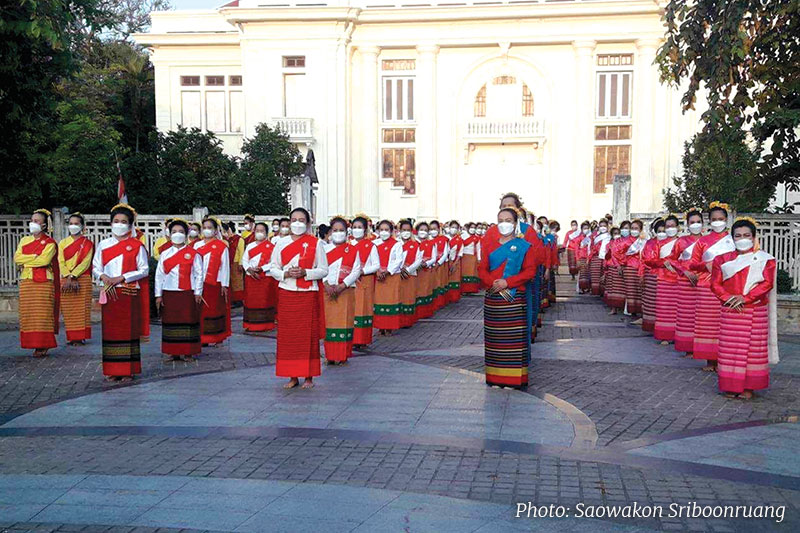
Traditional Lanna Dance: A Living Heritage Preserved
How does the traditional Lanna dance help preserve Chiang Mai’s cultural richness? Saowakhon Sriboonruang, a coordinator for Rak Chiang Mai Urban Community Network and owner of Chiang Mai Heart souvenir shop, points to the importance of intangible cultural heritage.
“Over the past decade, our community network has pushed Chiang Mai as a world living heritage city,” says Saowakhon.
“The term ‘world heritage site’ serves as a shield, safeguarding Chiang Mai’s exquisite and distinctive traditional cultures against practices that threaten the city’s identity.”
To keep the traditional dance alive, Rak Chiang Mai Urban Community Network holds regular training classes taught by masters, ensuring that the cultural heritage is passed down through generations. The network boasts over 900 dancers, ranging from five years old to 80, who participate in major events such as the annual Yi Peng lantern festival in November and Chiang Mai’s founding ceremony on April 12.
The network offers an innovative twist during the Yi Peng festival.
“We run a campaign to light phang [small clay-cup candles] instead of releasing sky lanterns,” Saowakhon explains. “This not only prevents potential damage to aircraft, public property and homes but also supports local potters.”
Over the years, the campaign has grown from 25,000 candles to over 100,000 candles in its 10th year.
“We also promote the display of tung [Lanna-style flags] around the city during Yi Peng,” she adds. This not only supports tung artisans but also adds a burst of colour to streets dur
“We also promote the display of tung [Lanna-style flags] around the city during Yi Peng,” she adds. This not only supports tung artisans but also adds a burst of colour to streets during the festival.
Working passionately to preserve their hometown’s essence, the “little people” of Chiang Mai are showing how a city can evolve sustainably amid break-neck development. Their stories weave a shimmering tapestry of local initiatives, reminding us that sustainable travel is not just an option but a delightful journey through culture, craftsmanship, and conscious living. www.facebook.com/Rakchiangmainetwork
